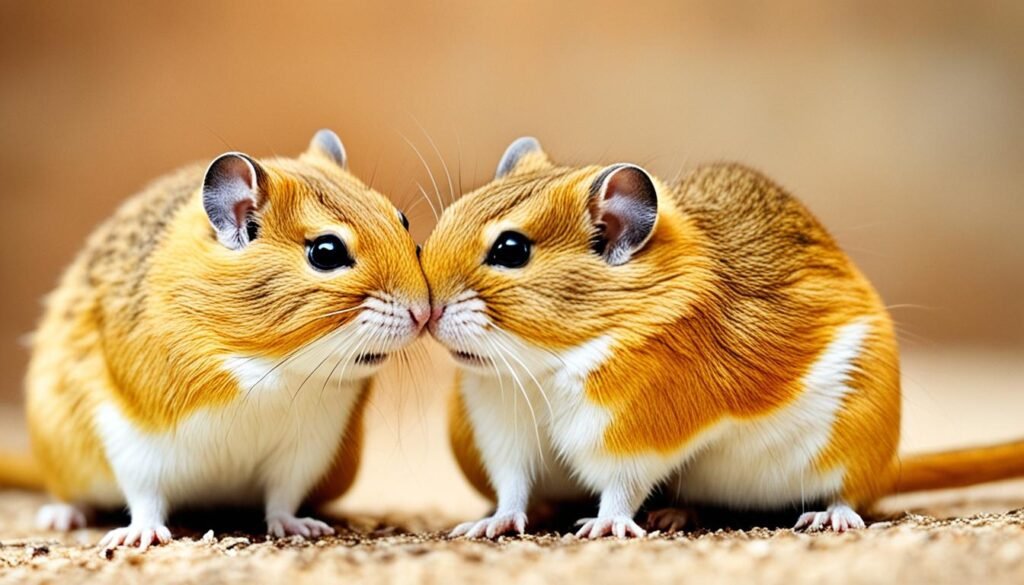Did you know that gerbils and hamsters are often mistaken for each other, despite their distinct differences? If you’re wondering what exactly sets these adorable rodents apart, you’ve come to the right place. In this article, we’ll delve into the fascinating world of gerbils and hamsters, exploring their contrasting behavior, physical characteristics, energy levels, social behavior, and more.
Whether you’re considering a new pet for your family or simply intrigued by these charming critters, learning about the disparity between gerbils and hamsters will help you make an informed decision. From temperament to lifespan, we’ve got you covered with all the essential details. So let’s dive in and discover what sets gerbils and hamsters apart!
Temperament
The temperament of gerbils and hamsters is one of the key differences between the two. Gerbils are generally easier to handle and more docile than hamsters. They are less likely to bite and can become tame with frequent handling. On the other hand, hamsters are known to be more skittish and may bite when scared or mishandled. Because of their temperament, gerbils are often recommended as good beginner pets, especially for children.
Gerbil Temperament
- Gerbils are generally easy to handle and tame.
- They are less likely to bite compared to hamsters.
- With frequent handling, gerbils can become docile and friendly.
Hamster Temperament
- Hamsters are often more skittish and prone to biting.
- They may bite when scared or mishandled.
- Hamsters require careful and patient handling to build trust.
Physical Differences
When it comes to comparing gerbils and hamsters, there are several physical differences that set them apart. Let’s take a closer look at these unique characteristics.
Gerbil Tails
Gerbils are known for their long tails, measuring up to 4 inches in length. These tails serve various purposes, including maintaining balance, communication, and thermoregulation.
Hamster Faces
On the other hand, hamsters have short and wide faces. Their faces often have a more chubby appearance compared to the long and pointy faces of gerbils. This facial structure gives them a cute and distinctive look.

As you can see from the image, gerbils have long tails and pointy faces, while hamsters have short and wide faces. These physical differences contribute to their overall unique appearance and help distinguish one from the other.
Energy Levels
Both gerbils and hamsters have high energy levels, but they differ in terms of activity patterns. Gerbils are active during the day and can interact with their owners throughout the day and night.
Gerbils enjoy socializing and thrive in pairs or small groups. They are playful and energetic, constantly exploring their surroundings and engaging in various activities. Their high energy level makes them a lively and entertaining pet to have.
On the other hand, hamsters are primarily nocturnal creatures. They are most active at night, which means they may be more active and noisy when their owners are trying to sleep. This nocturnal behavior is their natural instinct and allows them to forage and explore their environment. However, it is important to consider your own schedule and preferences when choosing between a gerbil and a hamster.
While gerbils can offer more interaction and playtime during the day, hamsters might be a better pet for those who prefer a quiet nighttime environment. If you have a busy schedule during the day or require a pet that is low maintenance during working hours, a hamster’s nocturnal behavior might align better with your lifestyle.
Ultimately, the decision between a gerbil and a hamster depends on your personal preferences, lifestyle, and availability to interact with your pet. Both gerbils and hamsters can make delightful companions; it’s important to choose the one that best suits your needs and energy level requirements.
Social Behavior
Gerbils and hamsters have distinct social behaviors that should be considered when choosing a pet. Gerbils are highly social animals and thrive in pairs or small groups. They enjoy the companionship of their own kind and find comfort in the presence of their fellow gerbils. Keeping a gerbil alone can lead to stress and loneliness for the animal.
On the other hand, hamsters are known for their territorial behavior and are generally better suited to live alone. They have a strong instinct to claim and defend their territory, which can result in aggression towards other hamsters. Introducing two hamsters without proper precautions can lead to serious conflicts, resulting in injuries or even death.
If you’re considering having gerbils as pets, it is crucial to provide appropriate socialization and companionship. Pairing them up or keeping them in small groups will ensure their social needs are met. Gerbils will thrive in an environment where they can interact and bond with their cage mates.
In contrast, hamsters are best kept as solitary pets. While they may tolerate the presence of their human caregivers, they may not enjoy the company of other hamsters. It’s important to keep in mind that hamsters can exhibit aggressive behaviors towards other hamsters, and attempting to house them together can cause unnecessary stress and harm.

Gerbils vs. Hamsters: Can They Live Together?
In general, gerbils and hamsters should not be housed together. The stark contrast in their social behaviors can lead to conflict and harm. It is best to provide separate habitats for these animals to ensure their overall well-being and safety. By respecting their natural tendencies and providing suitable living arrangements, you can create the best environment for your gerbils and hamsters to thrive.
Hygiene and Care
Keeping your gerbil or hamster clean and healthy is essential for their overall well-being. Here are some important tips for maintaining gerbil hygiene, hamster hygiene, and providing appropriate housing for both species.
Gerbil Hygiene
Gerbils are naturally clean animals and do not require regular baths with water. Instead, they rely on sand baths to keep their fur clean and free of parasites. Provide a shallow dish filled with chinchilla sand or dust a few times a week for your gerbil to roll around in. This helps remove excess oils and dirt, ensuring a healthy coat.
Additionally, maintaining a clean environment is crucial for gerbil housing. Use an escape-proof cage with secure lids to prevent any accidental escapes. Gerbils are burrowing animals and enjoy digging, so provide a deep layer of bedding material, such as aspen shavings or paper-based bedding, to stimulate their natural behaviors.
Hamster Hygiene
Similar to gerbils, hamsters do not require regular bathing with water. Instead, they also enjoy sand baths to keep their fur clean and groomed. Use a shallow dish filled with chinchilla sand or dust, and offer it a few times a week. This helps control oils and keeps their skin and coat healthy.
When it comes to housing, hamsters also need an escape-proof cage with secure lids. However, their housing requirements differ from gerbils. Hamsters benefit from a variety of toys, tunnels, and enrichment to keep them mentally stimulated. This helps prevent boredom and promotes their natural behaviors.
Maintaining a Clean Environment
Regular cleaning of the gerbil or hamster cage is essential to maintain proper hygiene and prevent odor. Remove any soiled bedding and waste daily, and replace it with fresh bedding material. Every week, perform a more thorough cleaning by disinfecting the cage and all accessories with mild soap and water. Rinse everything thoroughly to remove any cleaning residue.
Remember to always wash your hands before and after handling your pet gerbil or hamster. This helps prevent the spread of germs and maintains hygiene for both you and your furry friend.
Proper gerbil hygiene and hamster hygiene, coupled with appropriate housing, contribute to the overall health and well-being of these small pets. By following these care guidelines, you can ensure a clean and comfortable environment for your gerbil or hamster.
Lifespan and Handling
Gerbils and hamsters have different lifespans and handling characteristics. Gerbils typically live between three to five years, while hamsters have a shorter lifespan of one to two years. When it comes to handling, gerbils are generally easier to handle and tame compared to hamsters.
Gerbils enjoy human interactions and can be held and played with for longer periods. Their docile nature makes them more tolerant of being handled, making them great pets for both adults and children. On the other hand, hamsters may be more prone to biting and are generally less tolerant of being held. They require gentler handling to gradually build trust and reduce the risk of being bitten.
Proper handling is crucial for the well-being and safety of both gerbils and hamsters. It is important to gently hold them, supporting their bodies and avoiding sudden movements. Regular interaction, such as hand feeding treats and providing toys for mental stimulation, can foster a stronger bond with your pet and help them become more comfortable with handling.
Remember, each gerbil and hamster has its own unique personality. Some may be naturally more social and easier to handle, while others may require more patience and time to become accustomed to human touch. Always respect their boundaries and handle them with care to ensure a positive and enjoyable experience for both you and your small furry friend.
